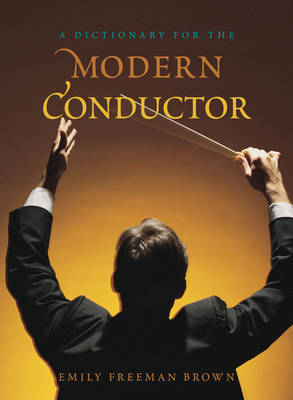
Stock image for illustration purposes only - book cover, edition or condition may vary.
Dictionary for the Modern Conductor
Emily Freeman Brown
€ 151.38
FREE Delivery in Ireland
Description for Dictionary for the Modern Conductor
Hardcover. In this book, author and conductor Emily Freeman Brown offers easy-to-read definitions of key musical terms, translated foreign terms, examples of usage from orchestral music, and practical vocabulary in multiple languages. Series: Dictionaries for the Modern Musician. Num Pages: 432 pages, 219 black & white illustrations, 43 black & white halftones, 11 tables. BIC Classification: AVS; GBC. Category: (G) General (US: Trade). Dimension: 293 x 226 x 31. Weight in Grams: 1316.
Titles in Dictionaries for the Modern Musician: A Scarecrow Press Music Series offer both the novice and the advanced artist key information designed to convey the field of study and performance for a major instrument or instrument class, as well as the workings of musicians in areas from conducting to composing. Unlike other encyclopedic works, contributions to this series focus primarily on the knowledge required by the contemporary musical student or performer. Each dictionary covers topics from instrument parts to playing technique, major works to key figures. A must-have for any musician's personal library! Filling a vital need in the ... Read more
Titles in Dictionaries for the Modern Musician: A Scarecrow Press Music Series offer both the novice and the advanced artist key information designed to convey the field of study and performance for a major instrument or instrument class, as well as the workings of musicians in areas from conducting to composing. Unlike other encyclopedic works, contributions to this series focus primarily on the knowledge required by the contemporary musical student or performer. Each dictionary covers topics from instrument parts to playing technique, major works to key figures. A must-have for any musician's personal library! Filling a vital need in the ... Read more
Product Details
Format
Hardback
Publication date
2015
Publisher
Scarecrow Press United States
Number of pages
256
Condition
New
Series
Dictionaries for the Modern Musician
Number of Pages
432
Place of Publication
Lanham, MD, United States
ISBN
9780810884007
SKU
V9780810884007
Shipping Time
Usually ships in 15 to 20 working days
Ref
99-15
About Emily Freeman Brown
Conductor and teacher Emily Freeman Brown has appeared with orchestras throughout the world including Europe, both North and South America and Asia. She was the first woman to receive a doctor of musical arts degree in orchestral conducting from the Eastman School of Music and is Director of Orchestral Activities and Professor of Conducting at Bowling Green State University.
Reviews for Dictionary for the Modern Conductor
Art isn't easy, and neither is pulling it all together in modern musical conducting. Brown touches upon `as many aspects as possible' relating to this topic, covering everything from the simple `a' (the pitch that is sounded for tuning an orchestra) to influential conductors such as Jaap van Zweden, principal conductor of the Dallas Symphony Orchestra. Included are eight appendixes ... Read more
